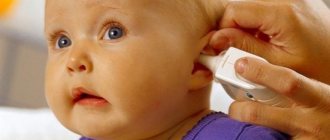A change in the temperature regime in four-month-old babies occurs during the activation of the protective functions of the body, which react with such symptoms to infection entering the child’s body. When the temperature of a 4-month-old child rises above 37 degrees, the bacteria begin to die and their reproduction is interrupted. As a result, pathogenic microflora dies out. Heat production in newborns works somewhat differently than in adults, heat production is active, and sweat glands are underdeveloped, so maintaining low-grade fever in infants in the first year of life can be considered normal.
Oral temperature measurement
37.4 for a 4 month old baby
A temperature of 37 4 in a 4-month-old child does not always indicate the presence of pathology or infection. After birth, the baby goes through quite a long path of adaptation to the environment. How long this process will take is an individual question: some children quickly get used to all the new conditions for them, others may suffer from ailments, runny nose, cough, intestinal infection and sleep problems. The children's nervous system is also not formed and will actively develop until the age of 10, so the physical and mental health of the baby undergoes complex transformations.
Important! In the first year of life, according to the vaccination calendar, most infants are vaccinated. As a rule, on the first and second days after, an increase in temperature may be observed - this is the body’s reaction to the introduction of a foreign substance. There is no point in doing anything about it unless the thermometer reads 38-39 degrees.
Temperature measurements can be taken:
- During sleep, these will be the most accurate numbers;
- While awake.
Before and after breastfeeding, after waking up and when overexcited, the indicators will be inflated and inaccurate.
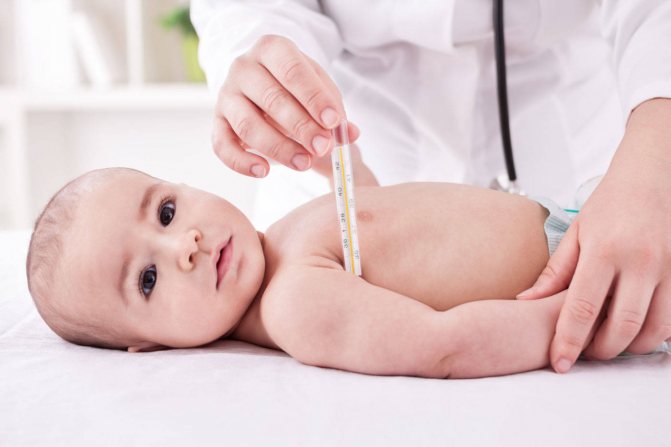
Babies may have a fever in the morning
Normal temperature values
People are used to thinking that 36.6 is the norm and a sign of absolute health. However, a temperature of 37 4 in a 4-month-old baby is not necessarily a sign of the presence of the disease. A child at four months old has normal temperature readings of 37 and 37.2. But these values may not always be constant. At this age, the thermometer can show from 36 to 37.4, and this is the norm for children from birth to one year. The method of measurement and type of thermometers can contribute to different temperature readings.
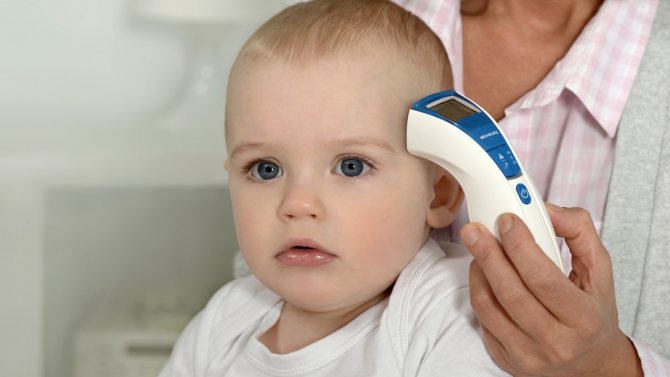
Non-contact thermometer
37 degrees in a baby in the fourth month of life is considered normal, so it makes no sense to provide any assistance. If the fever begins to rise, antipyretics should be used.
Note! Children under 5 months should only lower their temperature at 38 degrees, and from 6 months - at 38.5. If you begin to reduce the temperature with medication at lower thermometer readings, this can significantly impair the child’s immune health.
When a baby at 38 degrees is cheerful, active, and does not show any signs of illness, then there is no need to panic. First you need to make sure how reliable the thermometer readings are.
Normal temperature indicators
What temperature a child should and can have at 4 months depends on the baby’s living conditions, type of feeding and many other factors.
Usually, up to six months, a child rarely suffers from infections caused by viruses, since social contact is limited. It is still possible to catch the disease during a routine examination by a pediatrician or if one of the family members carries the disease. The temperature varies between 36-37.5 degrees.
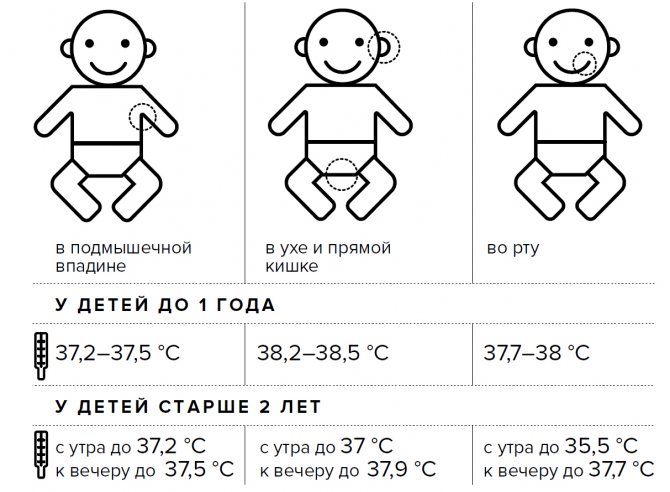
Indicators of normal temperature and methods of measuring it
Starting from six months, the risk of getting sick increases: complementary feeding is introduced, the baby is in active contact with other children and adults, and can catch chickenpox, rubella, and ARVI.
You should monitor the child’s condition and seek the help of a specialist if the following symptoms are detected:
- the baby is lethargic and weakened – this is a sign of the onset of an infectious disease;
- a runny nose appears, the color of the snot is yellowish-green - an allergic reaction or a cold;
- dry cough – the onset of bronchitis, pneumonia, colds or allergies;
- hoarse voice - this happens in the case of measles, tonsillitis, influenza, diphtheria, asthma, pneumonia;
- vomiting began - a consequence of food poisoning, gastrointestinal diseases, encephalitis, meningitis;
- diarrhea – the presence of an intestinal infection;
- headache – a consequence of ARVI, influenza, sinusitis, thermoneurosis, intoxication;
- abdominal pain - the onset of acute respiratory infections, poisoning, tonsillitis, whooping cough, measles, the presence of a foreign body in the stomach.
Additional Information. If a child's infectious disease is not treated, it can cause complications: pneumonia, bronchitis, tonsillitis and sinusitis. Therefore, it is important not to miss its onset, which usually manifests itself in an increase in body temperature.
Low-grade fever is normal
The normal temperature of a 4-month-old baby can be completely different at different times of the day. The most important thing is that the baby should be active, cheerful and cheerful, and have a good appetite.
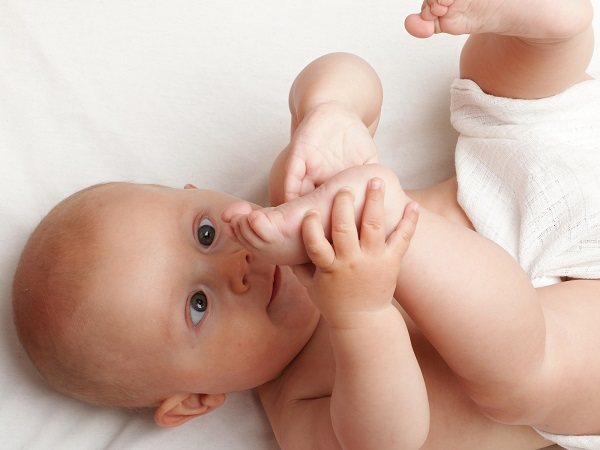
If the baby is active and cheerful, there is no reason to worry
If the measurements are accurate, then if the readings are elevated, the fact of teething or vaccination that was done the day before should be excluded, since in these cases the temperature can be kept around 37.2-37.6. You should wait a while, a few days.
In addition, low-grade fever is a consequence of imperfect thermoregulation of the infant, which does not require any intervention. You should contact your pediatrician if your baby has chills, sneezing, lethargy and moodiness.
A child’s temperature is 37: is this normal for a newborn and infant?
A temperature of 37 in young children causes parental concern. On the one hand, this is not a fever when you urgently need to bring down high performance.
On the other hand, low-grade body temperature (37.1-37.4 ºС) may indicate the inability of the child’s body to resist the disease to its full potential.
Before giving medicine or rushing to the doctor, you should make sure that the readings are measured correctly.
Low-grade fever may be a sign of the body's inability to resist illness
Rules for measuring temperature
When an increase in temperature is not accompanied by a cough, runny nose, indigestion, overheating and other symptoms, you should make sure that it is measured correctly.
No matter how accurate the thermometer is, there are exceptions that can change the indicators upward:
- Crying and screaming can increase normal values. Before measuring, you should calm the baby down, and only then put on the thermometer.
- After excitement, stress, a hot bath, physical activity, outdoor games, or a long stay in a stuffy room, the data may be distorted. Measurements should be taken 30 minutes after returning to a normal calm state.
- Humidity distorts the readings, so before placing the thermometer you should make sure that the baby’s armpit is dry.
- The highest values are observed in the evening (they reach 37.5 ºС). In the morning hours the parameters are the lowest. To obtain accurate information, measurements should be taken during the day, at the same hour.
The first measurement may reveal that the temperature is slightly elevated. In this case, it is worth eliminating the above factors and checking the accuracy of the device.
Electronic thermometers may show incorrect data, so you should double-check the measurements using a mercury thermometer (for more details, see the article: How should you measure a baby’s temperature with an electronic thermometer?).
It is a good idea to confirm the accuracy of the electronic thermometer by taking the readings of one of the older members of the household.
The indicators of a conventional mercury thermometer are considered the most reliable.
Is low-grade fever considered normal?
Once the accuracy of the measurements has been confirmed, teething and recent vaccinations should be excluded. These factors allow values to increase to 37.2-37.5 ºС and require a wait-and-see approach. Also, low-grade fever may indicate imperfect thermoregulation, which does not require treatment.
Sea temperature without symptoms
Parents often travel with their babies to the sea. Air, sun and water in moderation are good for the baby, but sometimes his temperature rises.
The reason for this is:
- Acclimatization after two days of stay at the resort. A slight increase is natural; it indicates the body’s adaptation to new conditions and is accompanied by lethargy and moodiness.
- Food poisoning, in which the temperature reaches 38 degrees, indigestion and vomiting occur. It usually goes away within three days, but requires a doctor's examination.
- Sunstroke, heatstroke, which are accompanied by increased pulse and heartbeat, vomiting, headache (more details in the article: heatstroke in children: first aid when symptoms appear). This condition requires urgent medical attention.
While the child is at sea, the temperature may rise due to acclimatization (we recommend reading: symptoms of acclimatization in children after the sea)
Why does a baby have a temperature of 37º?
When the reading is 37.1 ºС in a 3-month-old child, it is important to focus on the baby’s condition. When he is active, eating and sleeping well, there is no cause for concern. In the first month of life, 37º C for a baby is considered normal.
Doctors distinguish transient hyperemia - a condition when in the first hours of life a newborn’s temperature rises to 38 ºС, then drops to 36.5 ºС and again rises slightly to 37.2 ºС.
They explain low-grade fever by physiology:
- Newborns. 37.1 ºС in newborns is a variant of the norm. Most often, such indications occur in premature babies. The formation of thermoregulation can last up to a year.
- First 4 weeks. A variant of the norm is a temperature of 37.1-37.5 ºC per month in a baby after vaccination against viral hepatitis. Another reason is the continued formation of thermoregulation.
- 2 months. In a 2-month-old baby, low-grade fever is observed after vaccination against pneumococcal infection or due to the continued development of body temperature with age.
- 3-4 months. During this period, the baby is vaccinated against tetanus, whooping cough, polio, and pneumococcal infection. After vaccination, the baby’s temperature may rise to subfebrile levels within 3-5 days. This is the norm, but it is important to carefully monitor the baby’s well-being.
- 5 months of age. At this time, mothers begin to feed their babies and low-grade fever may be caused by a reaction to a certain product. This is confirmed when the child has a tummy ache, loose stools, and flatulence.
- Six months. At six months, many babies have an increase in temperature due to teething. It can last up to 5 days. It is worth taking all measures to ensure that the process of teeth coming out is painless. There are special gels for this, and when the baby is too restless, you can give an anesthetic.
An increase in temperature to subfebrile levels can be observed after routine vaccinations
Overheating of the baby
In many cases, the cause of a rise in temperature in a child is overheating. The baby does not have developed sweat glands, through which sweat is released in hot weather. Overheating under a layer of warm clothing, he does not sweat (see also: what to do if a baby’s head sweats during sleep?). A caring mother sees this and thinks that the baby is cold and wraps him up even more.
INTERESTING: How can you lower your child’s temperature?
Infants tolerate overheating worse than cold. The face turns red, heat rises, and prickly heat may occur. In such a situation, you should reduce the temperature in the nursery to 22 ° C and humidify the room. It is important to immediately change the baby into light cotton clothes, attach it to the chest or give water from a bottle. The fever will gradually go away without medication.
Protein complementary foods
The mother's first protein supplement is introduced at 6-8 months. When the daily diet contains a lot of protein products (eggs, cottage cheese, meat puree) and little plain water, the baby may experience protein fever.
It is accompanied by an increase in temperature to 37.5 °C and above, and a sharp decrease in the frequency of urination. Sometimes a large fontanel may become sunken. The child drinks greedily, but does not give the impression of being sick.
In this case, it is important to give the baby water often, then the symptoms of fever will gradually go away.
Dysbacteriosis
Violation of the intestinal microflora also causes an increase in temperature in an infant. Beneficial microbes in the intestines die, giving way to harmful ones. The toxins they release enter the bloodstream and cause fever. It is accompanied by poor appetite and unstable stool. In this case, it is important to give a test that will confirm dysbacteriosis and undergo treatment from a doctor.
What does a temperature of 37 and additional symptoms mean?
Usually, up to six months, babies rarely get sick with viral and bacterial infections. Contact with society is limited, but even in this case, diseases can be picked up at the clinic during a routine appointment or infected from one of the family members.
After the 6th month of life, the risk of getting sick increases. Complementary feeding begins and contacts with other children begin, which increases the likelihood of contracting rubella, chickenpox, and ARVI.
A condition that requires special attention is when the baby’s fever is accompanied by the following symptoms:
- lethargy, weakness – the onset of an infectious disease;
- runny nose - allergies, colds;
- cough is a symptom of allergies, colds, incipient bronchitis, pneumonia;
- hoarse voice – tonsillitis, measles, laryngitis, influenza, asthma, pneumonia, measles, diphtheria;
- vomiting – food poisoning, gastrointestinal diseases, encephalitis, meningitis;
- diarrhea – intestinal infection;
- headache - ARVI, flu, sinusitis, thermoneurosis, intoxication;
- abdominal pain – sore throat, measles, acute respiratory infections, whooping cough, food poisoning, appendicitis, foreign body in the stomach.
Infectious diseases of the baby are fraught with complications - pneumonia, bronchitis, sinusitis, tonsillitis. It is important for the mother not to miss their start, to show the child to the doctor on time and to get appointments. Low-grade fever can persist for a long time after taking antibiotics and severe illness.
In this case, treatment is not required, but the situation must be kept under control. Repeated runny nose, cough and other symptoms indicate a relapse or the addition of a new infection. It is important to consult a pediatrician to prevent complications and find out why the temperature rises.
What to do if the temperature stays at 37 for more than a week?
An occasional increase in temperature usually indicates overheating or measurement errors. In this case, it is important for parents to monitor the condition of the baby and record changes in the diary. When the baby is active and nothing bothers him, treatment is not required.
If low-grade fever persists for more than a week, you should not rush to take antipyretics.
In any situation, even if the baby feels well, it is important to take the following measures:
- Find out what is bothering your baby - pain, runny nose, cough, etc.
- Maintain a drinking regime - elevated temperature disrupts water-salt metabolism and provokes dehydration. You should put the baby to your breast more often or give him water from a bottle. Older children can be offered cranberry juice and dried fruit compotes.
- If your health suddenly deteriorates (wheezing, vomiting, convulsions, difficulty breathing, fever due to antipyretics), call an ambulance, otherwise make an appointment with a doctor.
- Create a comfortable microclimate in the baby’s room – moderate humidity, air temperature 21+22 °C. In a dry, hot room, ARVI in infants is often fraught with complications in the form of bronchitis, otitis, and pneumonia.
- Dress your baby in light clothing if he is not chilly. A thin knitted blouse and rompers are ideal. While sleeping, the baby can be covered with a thin fleece blanket.
READ ALSO: how and with what to treat ARVI in a newborn?
Often a child has a temperature of 37 or higher after vaccination. It is important for the mother to monitor the baby’s condition and report any changes in his health to the pediatrician. Antipyretics in this case should be given judiciously, since the vaccine can cause hypothermia. The action of paracetamol or ibuprofen will only worsen the situation.
READ ALSO: What should be the normal temperature for a child under one year old? At elevated temperatures, the child’s body loses a lot of fluid, so it is necessary to regularly replenish its supply (see.
also: is it necessary to lower the child’s temperature at all if it is 38 degrees?)
When and how to lower the temperature?
If the baby’s temperature has not reached 37.5 °C and passes without symptoms, it is not recommended to bring it down (this can weaken the child’s already imperfect immunity).
An assistant to young mothers in raising healthy babies, Dr. Evgeniy Komarovsky, believes that a temporary increase in temperature does not pose a threat. However, in order not to scold themselves later for slowness and sluggishness, parents should show the baby to a competent doctor.
READ ALSO: what does Komarovsky say about a baby’s temperature?
The dangers of low-grade fever
With a low-grade fever, an infant may not be bothered by anything, but apparent well-being can be deceptive.
A prolonged, even slight increase in temperature can signal hidden problems in a child’s body - anemia, helminthic infestation, infections, brain disease.
They can only be detected through a thorough medical examination. When no pathologies are identified, attention should be paid to strengthening the baby’s body’s defenses.
Preventive measures
A prolonged increase in body temperature leads to chronic stress in the body. When doctors convince you that this is a variant of the norm, you should still try to bring the indicators to 36.6.
Prevention of fever includes hardening, proper daily routine, regular walks, identification and treatment of foci of infectious diseases.
These measures strengthen the immune system, help establish thermoregulation and cope with low-grade fever.
Source: https://VseProRebenka.ru/zdorove/simptomy/u-rebenka-temperatura-37.html
Why does the temperature rise
If the readings rise above 37.5 degrees, this indicates the onset of the disease. Most often it can be ARVI, overheating, teething or flu.
The most popular causes of fever among infants are:
- The onset of infectious childhood diseases: chickenpox, rubella, scarlet fever, whooping cough, measles. They can usually be found in children aged 2-5 years, when they begin to go to kindergarten and visit other institutions.
- Baby teeth will be coming through soon. From three months, the baby begins to put everything in his mouth, salivation increases, snot and runny nose appear, and the temperature may rise. The indicators do not rise above 38-39 degrees, and fall off for a short time.
- Presence of intestinal infection. In some cases, as early as four months, children are introduced to complementary foods that may contain pathogenic microorganisms. Once in the intestines, they contribute to the rapid development of poisoning or disorders. Symptoms of vomiting, diarrhea and abdominal pain appear.
- Inflammation of the upper respiratory organs: pharyngitis, laryngitis, otitis media, tonsillitis, pneumonia. In the treatment of these ailments, antibiotics are required.
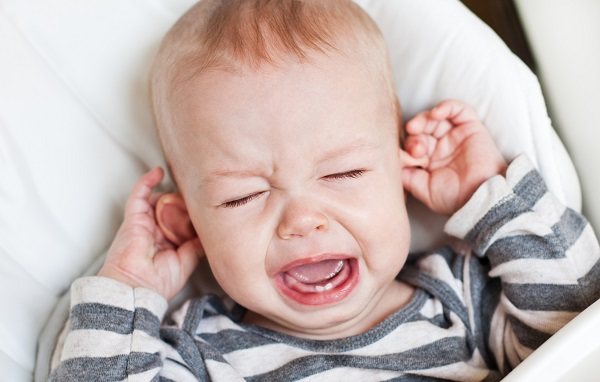
Otitis in a baby
- The onset of a viral illness: ARVI, influenza and colds. Infection occurs through contact with a carrier of the disease. Treatment is carried out in combination with therapy and drug intervention.
Note! To prevent your baby from overheating, you should not wrap or swaddle him; it is advisable to dress him according to the weather. It is important to provide all the conditions for a comfortable microclimate in the room to prevent the development of various ailments.
Causes of fever in infancy
The most common causes of fever in infants 4 months old are:
- childhood infectious diseases (chickenpox, measles, rubella, scarlet fever, whooping cough);
- ARVI - colds and flu;
- intestinal infections (usually the pathogen enters the gastrointestinal tract along with complementary foods or water);
- teething (usually begins later, but some children have their first teeth at 4 months);
- inflammation of the upper respiratory tract (pharyngitis, tonsillitis, rhinitis), lungs (pneumonia), middle ear (otitis), as well as other organs.
In addition, overheating can provoke a rise in temperature by 0.5-1 degrees - tight swaddling, excessive heating of the room, prolonged exposure to sunlight, clothing not suitable for the weather.
How to relieve fever correctly
At four months the temperature does not drop below 38 degrees. If you give an antipyretic at this moment, it can provoke an even deeper exacerbation.
Initially, the reason that caused this situation is indicated. The best solution is to consult a doctor who will prescribe treatment or, in the case of teething, suggest options for relieving the symptom.
If the thermometer shows high values, first of all, the baby needs additional fluids and hydration. You should feed breast milk more often and lubricate the baby's body with a sponge.
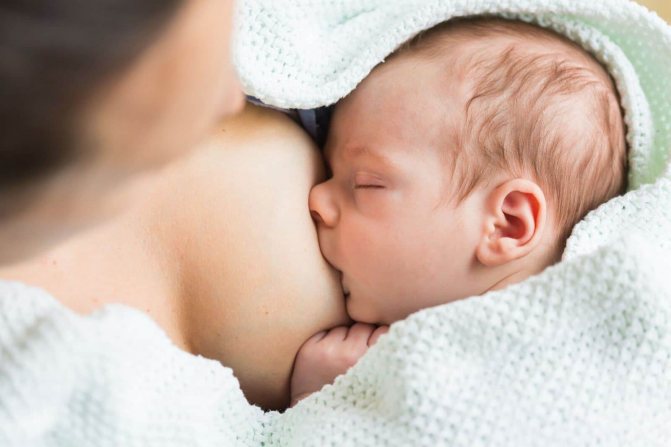
Gv, drinking plenty of fluids - help in reducing fever
Having identified the cause, you can begin treatment after coordinating it with your pediatrician. In case of pneumonia, antibiotics and sputum thinners are prescribed. Simply taking an antipyretic drug is not enough and is unacceptable - this will worsen the situation.
In most cases, relieving a fever is not a cure; it can often simply hide the underlying problem for a period of time.
Note! Under no circumstances should you wipe your baby with vodka, vinegar or alcohol, as this can cause intoxication of the body. It is also prohibited to wrap very young children in cold diapers, as this will provoke vasospasm and further convulsions.
Up to a value of 38.2, the baby should be wiped with water and compresses should be applied: safe physical methods should be used. The well-known pediatrician and candidate of medical sciences, Evgeniy Komarovsky, believes that a temporary increase in temperature does not pose a threat to the baby, but it should definitely be shown to a competent specialist in order to exclude the presence of serious illnesses.
Choosing an antipyretic drug
Drugs that contain aspirin and analgin are contraindicated for newborns. In many countries around the world, even adults are prohibited from taking them. For infants, antipyretics are available in the form of a suspension, syrup or rectal suppositories.
What options can be purchased at the pharmacy:
- Children's paracetamol, analogues of which are Panadol, Efferalgan. They relieve pain. The syrup is consumed at intervals of 4 hours, 5-8.5 ml.
- Ibuprofen. Relieves inflammation and painful reaction. Can be used from six months, in the form of suppositories - from three months. It is advisable to use no more than 3 days in a row, 3 times a day, exclusively at high temperature readings. The suspension is used in 2.5 ml doses, suppositories - 1 suppository every 6-8 hours.
Important! The dosage and dosage regimen should be strictly adhered to, taking into account the weight and age of the patient. If the temperature cannot be brought down, you should call an ambulance and not exceed the recommended dose of the drug.
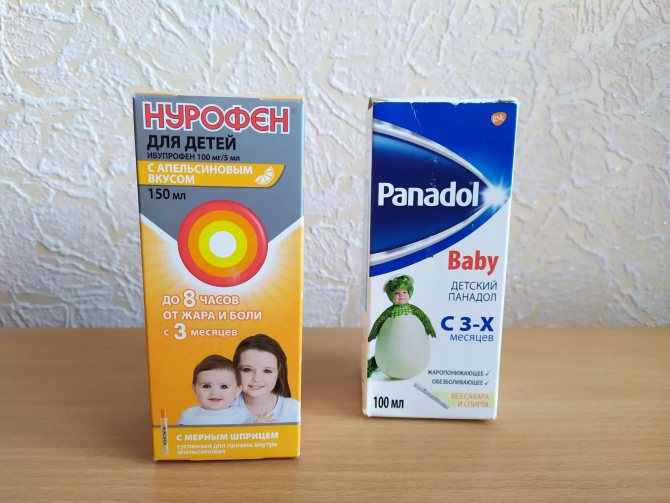
Antipyretics for children
Ways to relieve fever
What to do if a 4-month-old child’s body temperature rises to 38 degrees? It turns out there is no need to shoot it down. Pediatricians say that such indicators are not dangerous for children. And since fever is just a symptom and not a disease, it is necessary to find its cause and begin treatment. Then the temperature will return to normal.
For example, if a child has pneumonia, he needs treatment consisting of antibiotics, drugs to thin the sputum, stimulate the contraction of the airways, inhalation, etc. Simply taking an antipyretic in this case is unacceptable - it will only worsen the situation. In addition, relieving the fever will create a false impression of improvement in the patient's condition, while the disease will continue to progress.
Thus, relieving fever is not a cure in most cases. This will only hide the problem, but will not solve it.
If, in addition to fever, you do not notice other symptoms of the disease, consult a doctor. The pediatrician will help determine its cause and select the necessary treatment.
37.4 lasts more than a week
If the readings change from time to time, this is either measurement errors or evidence of overheating. You should monitor the baby and record his changes in behavior and condition. If it is active, then no treatment is needed. When low-grade fever persists for more than a week, there is no need to rush into taking antipyretics.
Proceed as follows:
- Find out what is bothering the baby: runny nose, cough, pain.
- Be sure to follow a drinking regime. As the temperature rises, the water-salt balance is disrupted and dehydration occurs. Put your baby to your breast more often, give him some water to drink from a bottle - that’s all you need. Older children can be offered cranberry juice or dried fruit compote.
- If the condition worsens, wheezing, convulsions appear, vomiting occurs, breathing is difficult, and the temperature begins to rise even after taking medications, be sure to call an ambulance.
- A certain microclimate should be created in the children's room - 21-22 degrees Celsius, moderate humidity. If the air is dry, complications may occur: bronchitis, otitis media, pneumonia.
- If the baby is not cold or shivering, then dress him in light clothes made from natural fabrics: rompers, a cotton shirt or blouse are ideal. When the baby is sleeping, cover him with a fleece blanket or flannel diaper.










